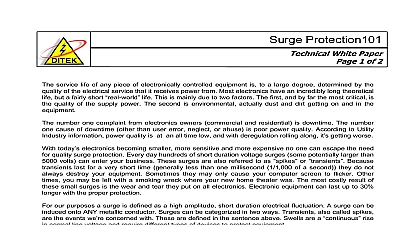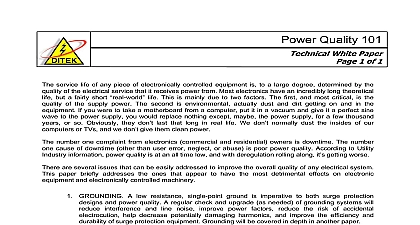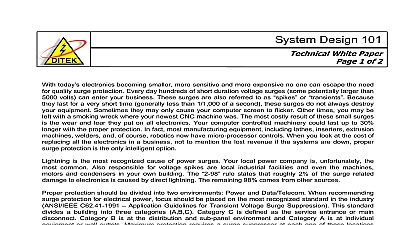Ditek 4 Grounding 101

File Preview
Click below to download for free
Click below to download for free
File Data
| Name | ditek-4-grounding-101-6328597410.pdf |
|---|---|
| Type | |
| Size | 623.92 KB |
| Downloads |
Text Preview
Grounding 101 White Paper 1 of 3 service life of any piece of electronically controlled equipment is to a large degree determined by the of the electrical service that it receives power from The number one complaint from electronics and residential owners is downtime The number one cause of downtime other than user error or abuse is poor power quality According to Utility Industry information power quality is at an all time and with deregulation rolling along it getting worse low impedance ground is imperative to both surge protection designs and power quality A regular check and as needed of grounding systems will reduce interference and line noise improve power factors the risk of accidental electrocution help decrease potentially damaging harmonics and improve the and durability of surge protection equipment Since many electricians use the terms and interchangeably for the purpose of this paper they will be defined in short as follows Any direct conducting connection between an electrical circuit or equipment The permanent connection of metallic parts to form an electrically conductive earth example would be an electrical service panel that is grounded while the telecommunications rack is to the grounding system primary concern that needs to be addressed when beginning any power quality survey is the need for a grounding and bonding system between the electrical service entrance and remotely grounded or equipment If the remote ground home runs back to the service entrance it will be a relatively process to create a point ground that will reference the initial utility company electrical ground at the service entrance electrical meter 100 and 250 of the NATIONAL ELECTRIC CODE NEC describe an acceptable ground as being at 25 Ohms of resistance or less and requirements to achieve this Optimum performance of surge is achieved at five Ohms or below Several manufacturers of electronic equipment also require to ten Ohms as a maximum resistance for their gear to work correctly Failure to properly ground the parts of the electrical system to the earth can result in electric shock fires and the destruction of electronic equipment from lightning and high voltage line surges We realize that in many areas of country you may be starting with 350 ohms or more instead However there are several preliminary that we can perform to reduce that number to a more acceptable level first and most important task to undertake is the actual measurement of resistance to ground at the entrance meter electrical ground or of the soil itself Several things can affect the actual resistance the soil including moisture content quality and type of electrolytes conductive objects temperature depth spacing of the ground rods This critical measurement can be accomplished in one of two ways either the use of a special ground resistance measuring device good for existing locations or an resistance meter preferred in new installations Although the earth resistance meter is less it requires the use of multiple ground probes and leads from the tester with specific distance between rods and measurements to be plotted on a nomograph in order to calculate the actual of the ground DITEK Center Starkey Road FL 33771 Direct 1 727 812 5000 Support 1 888 472 6100 Number STS 100006 001 Rev 1 10 07 DITEK Corp Subject to Change 101 White Paper 2 of 3 issue with the Megger is that they come in three and four terminal configurations To test the actual of the soil itself a four terminal model is required The advantage of this method is that you are not to the electrical system during testing An electrical line fault during testing can send high current the grounding system This could result in high current and voltage at the test leads and meter Safety is a concern working on electrical systems Always use proper protection equipment Remember if are in contact with the grounding system particularly if the ground rod is disconnected YOU are the for the system an accurate measurement of resistance to ground has been calculated we can perform a few tasks to reduce resistance even further Since DITEK is in Florida and geological features can vary greatly in parts of the country it will fall to the installing contractor to make the determination of how best to lower to ground in his region The recommended grounding conductor at the service entrance is by NEC based on the ampacity of the service a new service entrance ground rod Since it is impossible to know the exact length or current of the original ground rod it may be prudent to install a new rod of suitable length and at the service entrance Solid copper is the preferred material however galvanized or clad may also be suitable if acceptable resistance levels are met a new rod and the existing rod together If the target ground resistance is not achieved by a new drive a second rod and bond the two rods together by exothermic welding a piece of the conductor between the two The new rod should be approximately one rod length or more the first rod Multiple rods can be connected this way See item 4 below One additional rod lower ground resistance by 40 Two rods will result in a 60 reduction Three rods will improve by 66 the rod deeper Couple a new rod of equal length on top of the existing rod to effectively double depth of the rod Be sure to use rods of like type and a coupler matched to that type of rod This result in an approximate 40 reduction in ground resistance a Grid This procedure involves creating a grid of grounding electrodes or rods in proximity 10 to 20 feet or at least one rod length apart and welding or bonding the grounding between the rods together The entire grid is then backfilled with soil and compacted to the grid Also review NEC section 250 32 b for more information a Ground or Ring If your region provides a solid substrate such as bedrock below a shallow layer of soil it is possible to create a circular trench around the building 20 feet long at least 30 inches deep utilizing a minimum of 2AWG bare copper lay in the grounding conductor bond the two ends together to the ground rod and then the trench with soil This allows maximum contact with the ground yet need not be deep to do the job DITEK Center Starkey Road FL 33771 Direct 1 727 812 5000 Support 1 888 472 6100 Number STS 100006 001 Rev 1 10 07 DITEK Corp Subject to Change 101 White Paper 3 of 3 key element to the creation of a complete grounding system may involve making some fundamental to the routing of the grounding conductor if more than one ground can be referenced campus etc This will not be difficult or time consuming but is very important in the system ability to the original equipment ground back at the service entrance utility service meter The normal routing be to bring the HOTS the NEUTRAL and the GROUND wire into the remote electrical panel and them to the appropriate busses Then route the GROUND wire down to the house grounding ground rod For our purposes it is necessary to route the GROUND wire to the grounding FIRST and then up to the ground bus within the panel This simple adjustment still follows NEC but provides an unobstructed pathway to divert surges to these ground rods while continuing to the service entrance ground The fundamental result of this routing is the elimination of potential damage from the ground loop created by multiple ground rods It accomplishes this by allowing the potential of the entire facility to rise and fall in a uniform manner reducing the possibility of excessive flow on the grounding system Please note the diagram 1 for a sample layout inspect and tighten all wiring terminations at the service entrance and at each of the remote panels or equipment It is surprising how over time these terminations can loosen It can make a difference in lowering resistance to ground if these connections are i


